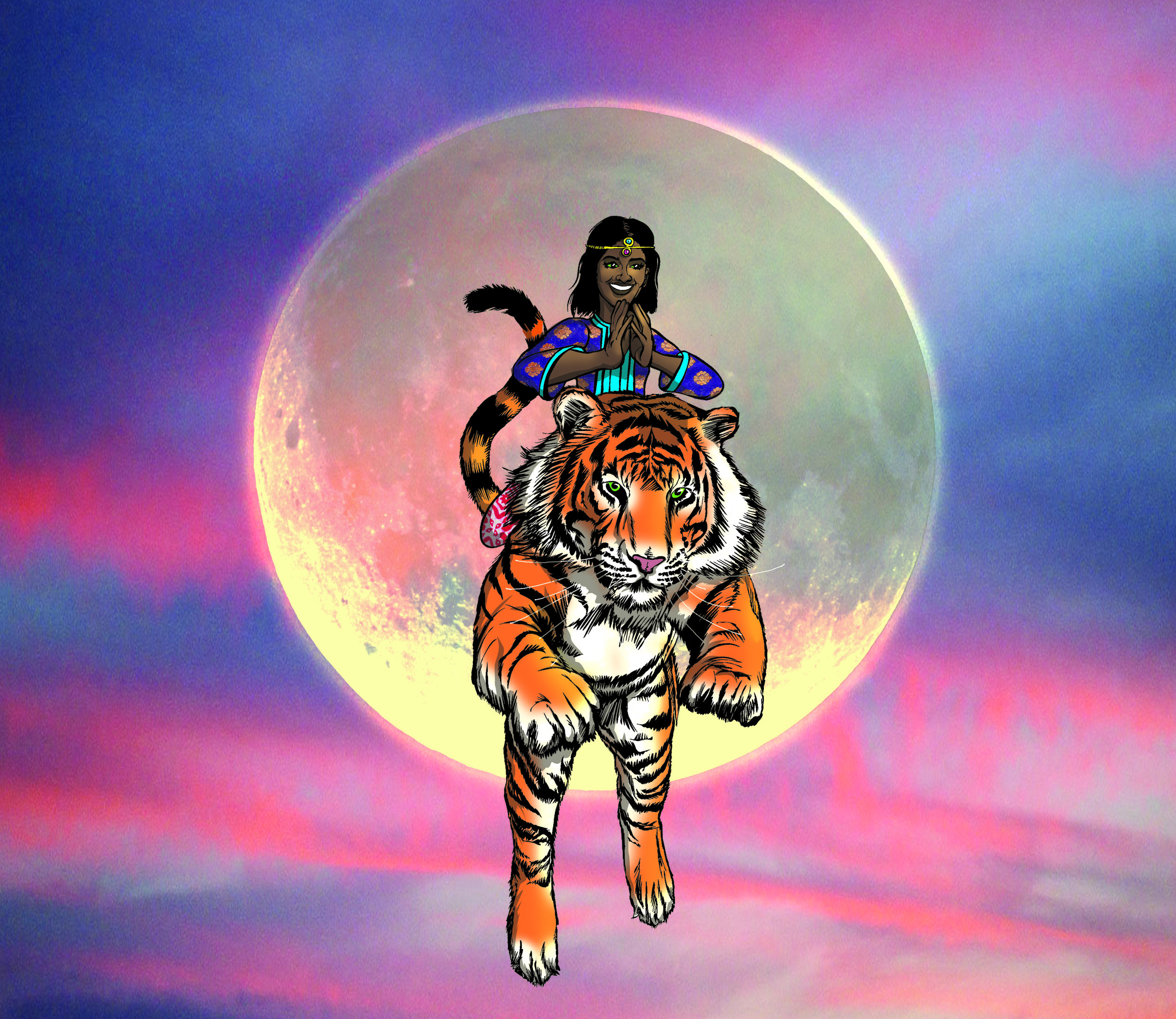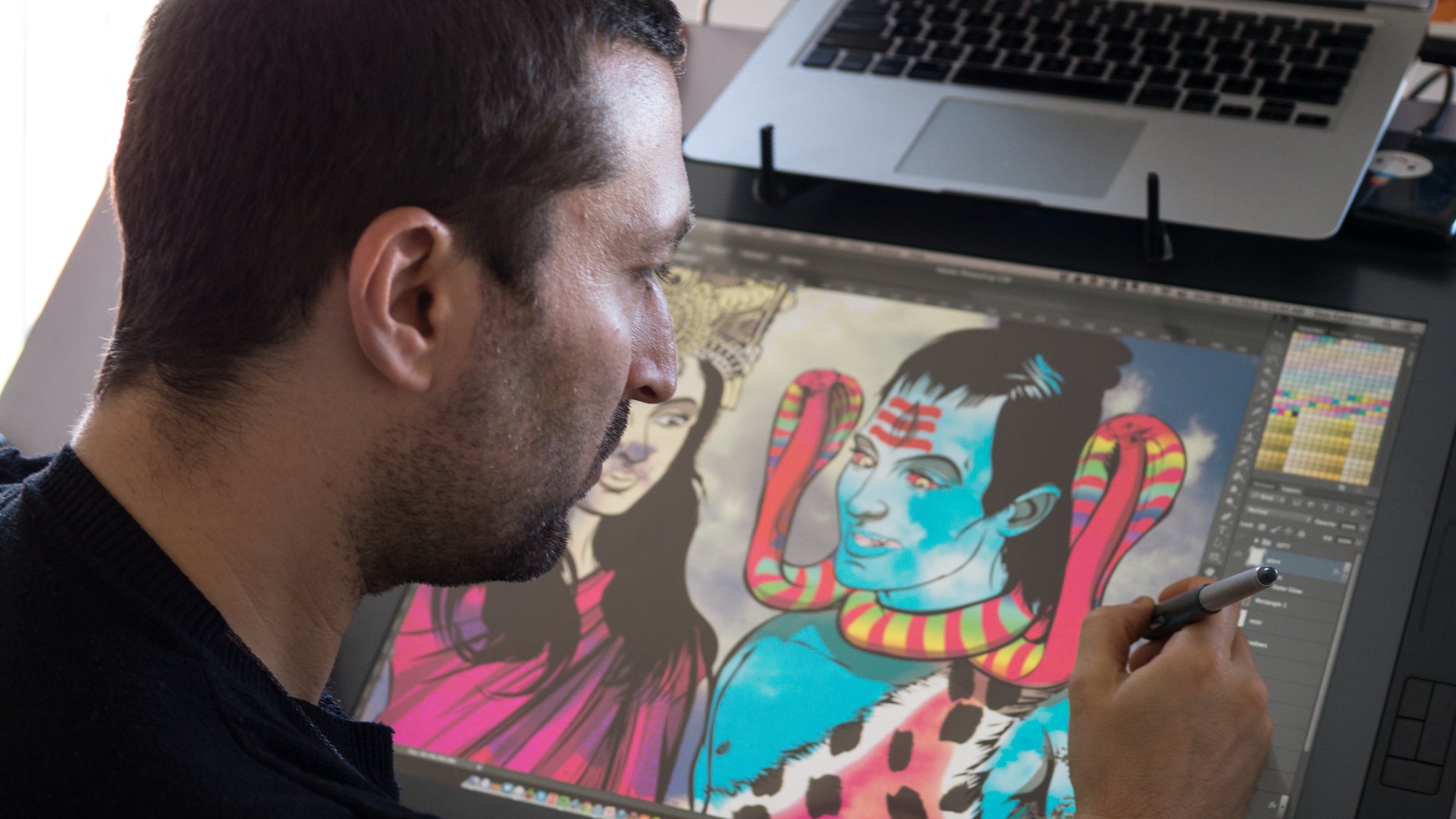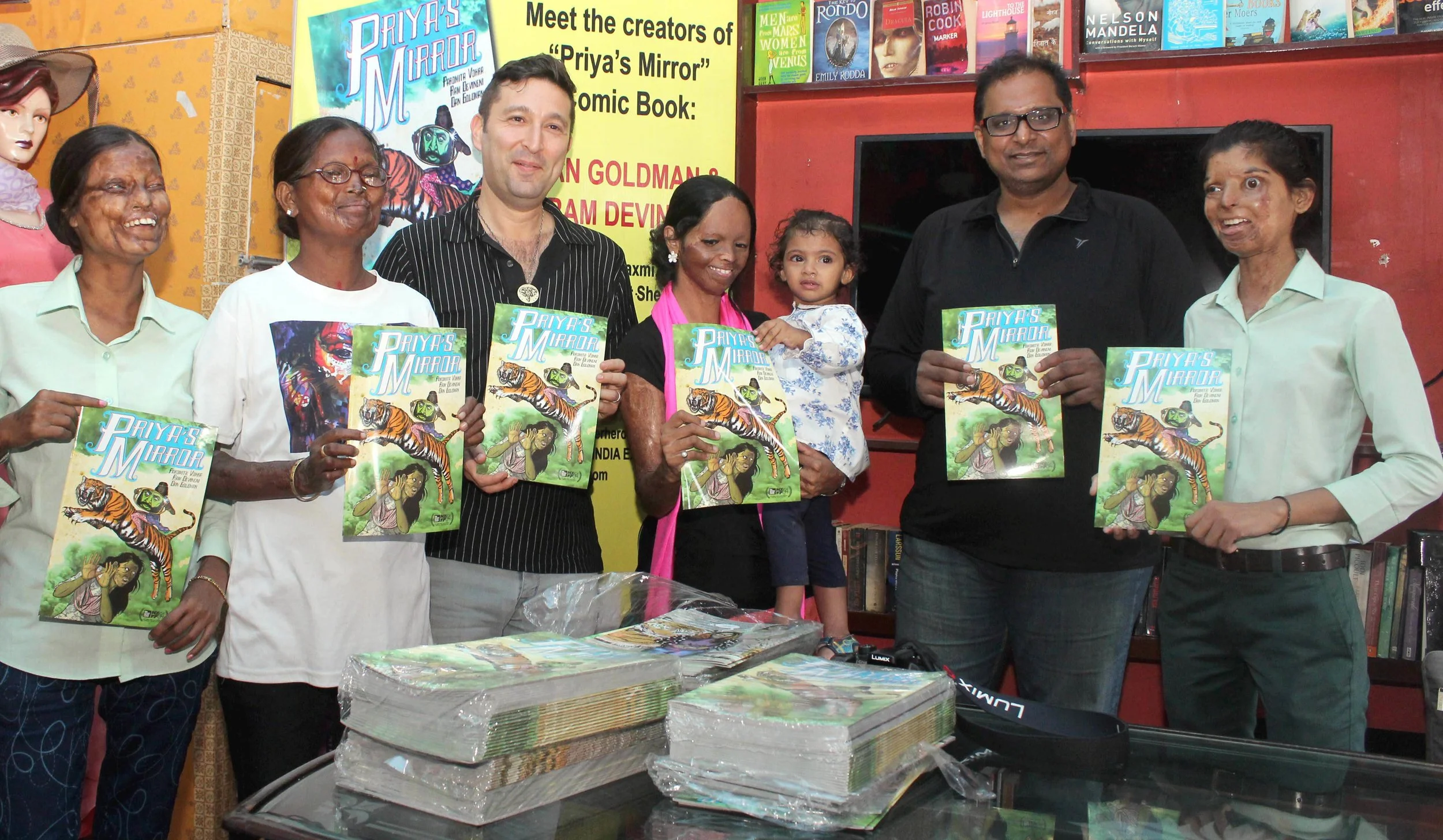Priya's Shakti: A comic book fighting gender based violence
This week, Lowercase had the great pleasure to interview the creators of “Priya’s Shakti”, a comic book that was created to address the glaring problem of gender based violence in India.
Just to put this in context, a horrific gang rape occurred in 2012 that really shook the world, we heard about it all the way out in North America. From that you got the idea to create this comic book to help empower women. How did it come about? Were you in the arts previously and so this was a natural thing for you to do or was it completely new to you?
This is the back-story on Priya, and some has been written about, but good reference.
I was in Delhi when the horrible gang rape happened on the bus in 2012, and was involved the protests that soon followed. Like many people, I was horrified by what had happened and angered by the indifference exhibited by government authorities at every level. There was an enormous outcry in particular from young adults and teenagers — both women and men. At one of the protests, my colleague and I spoke to a Delhi police officer and asked him for his opinion on what had happened on the bus. Basically the officer’s response was that “no good girl walks home at night.” Implying that she probably deserved it, or at least provoked the attack. I knew then that the problem of sexual violence in India was not a legal issue; rather it was a cultural problem. A cultural shift had to happen especially views towards the role of women in modern society. Deep-rooted patriarchal views needed to be challenged.
For about a year, I traveled around India and Southeast Asia learning from poets, philosophers, activists, and sociologists working for NGOs focused on gender-based violence. Talking with several rape survivors, I realized how difficult it was for them to seek justice and how much their lives were constantly under threat after they reported the crime. Their family, local community, and even the police discouraged them from pursuing criminal action against their attackers. The burden of shame was placed on the victim and not the perpetrators. This created a level of impunity among men to commit more rapes.
On a parallel journey of understanding, I began researching Hindu mythology and discovered the many rich stories involving regular people and the gods. Often a favourite disciple would call on the gods for help during dire situations. So, I began formulating a new mythological tale where a mortal woman and rape survivor would seek help from the Goddess Parvati — only after she had nowhere else to turn. Although Lord Shiva and other gods get involved, eventually it is up to her to challenge people’s perceptions. I wanted to create a new Indian “superhero” – Priya, who is a rape survivor and through the power of persuasion she is able to motivate people to change.
Art is never a linear process, often it is messy with lots of dead-ends. I originally was thinking about making a documentary film because I am a documentary filmmaker about what had happened on the bus, and the issue of gender violence in India, but felt the issue was too difficult and too sensitive to tell in narrative form. I am not a news reporter; rather I am a storyteller and filmmaker. Additionally, there was plenty of TV coverage and focus on the issue from the media, and it was very sensationalized. I felt to get at the root of the problem I needed to take another approach.
So, the first incarnation of the story was a remix film using dozens of Hindu “god epic” films from the 1970s as source material. The original popular Bollywood-style films were meant as both entertainment and morality tales for a wide Indian audience. The new re-mix film followed closely the storyline of the comic dealing with sexual violence and has a new soundtrack and music. The remix film was inspired by DJ Spooky’s remixing of D.W. Griffiths’ “Birth of a Nation,” which compelled audiences to examine race in America. When I finished editing the remix film, I looked at the materials and thought this looks like a comic book. That’s when I started looking at the comic book genre.
Just to clarify your project, apart from the comic book and the street art, how are you popularizing this? Is this being introduced in schools?
We are working with the Lions Club of India in testing the comic book in about a dozen schools in Delhi. It's a long process and the curriculum are not very flexible. Hopefully we will see some results soon.
In terms of how you brought this all together, many of you live on different continents, how did you guys come together to do it?
Initially, all of us were based in New York City, but now everyone is based all over the world. It was not a difficult process and I am good with collaborating and motivating creative people reach a single goal. A lot of late night skype calls and using Google docs to collaborate.
I was really struck by the choice of Parvati as the goddess chosen to imbue Priya with her specialness. It was really nice how the goddess chosen was one of motherhood, nurturing, love and beauty. In your comic book Kali confronts Shiva but you didn't choose her to be the inspiration for Priya's message. Can you comment on that?
Kali is just one of the many incarnations that are invoked by the Hindu gods. She is another manifestation of feminine power. In Hindu mythology, Parvati is the goddess that challenges Shiva, the others gods and humans to open their eyes to sensitivity and struggles of others. For her, wisdom is meaningless if it does not enable the liberation of those who are trapped in fear. So, her role is to challenge Priya to conquer her fears, but it is up to Priya to motivate and challenge other humans.
So, the Goddesses Parvati is the awakening light in Priya and Shiva; the Goddesses want Shiva and the human race to empathize with Priya and other survivors of rape. She motivates Priya to conquer her fears and find her Shakti and be the catalyst for change.
In my opinion, the core essence of Hinduism is about conquering your fears. In the story, Priya confronts the tiger that has been stalking her. She turns her fear, the tiger, in to her power — her shakti. Of course, Priya on the Tiger is an interpretation of the Goddess Durga on the tiger. Durga is the ultimate goddess of feminine power, but we re-imagined it by putting a rape survivor on a tiger. It is an icon image that people can understand, but are also challenged when they see Priya riding the tiger.
I think it's a very wise choice but also a really brave choice to make, when revenge is the first thing that come to mind after an assault like that one. Your message is one of knowledge, understanding and advocacy. Did you get resistance because of that? What was the reaction from rape survivors?
We have not faced resistance from anyone. Both acid and rape survivors have been universally supportive of the project because our main audience are teenagers -- and especially teenage boys. Talking about sexual violence issues and respect for women at early age is critical. We have gotten criticism on the story structure but this was creative criticism.
In your TEDx talk you highlighted a few interesting things, among them was a the idea of personal responsibility. Priya calls upon the gods but in the end it's up to her to spread her message. Do you have any other ways your helping empower victims of gender violence to speak out?
The second chapter “Priya’s Mirror “ is a better example of how to promote and work with survivors to create a comic book that reaches wide audiences. The second chapter was advised by and features the women who survived acid attacks. They utilized the comic book is their public outreach and used the comic book to talk about this topic which is often ignored by the media. So the second chapter was an incredible tool and platform for them . I am very proud of the campaign we did with our partners and the heroic women.
I understand that there are many cultures and many religions in India, but Hinduism is the major religion and spending some time here you get to realize that people are religious and practice.. I'm always impressed at the inherent feminine power of Hinduism and Shaktism. It's a very feminist religion, maybe even the most. How do you square that with the difficulty of being a woman in India? How come that doesn't come through more?
Priya means “love” . Shakti means “Power”. In the comic book, Priya is stalked by a tiger and one day she confronts with a powerful mantra. the tiger and turns her fear into Shakti or power. The tiger becomes her friend. The mantra is “speak with shame and stand with me, and bring about the change you want to see.”
I agree it is incredibly tough being a woman in India, but there has been enormous progress in the last decade resulting from urbanization and globalization. Many women have moved into the job market and living independent and happy lives, and this is the nature of living in a large city.
Although the comic book is set in rural India, I think the cultural stigmas and struggles of being a woman are similar for all women. That is why the comic book has been a global hit, and not just in India.
You guys use augmented reality in both your comic book and your street art, what made you decide to include that in your work?
From the beginning, I wanted the comic book to have an interactive component that is accessible and reach wide audiences in India and around the world. It was when I traveled to Italy and spent time in the Sistine Chapel did the idea of augmented reality fully come to me. I was captivated by the splendour of Michelangelo’s achievement. Each fresco panel told a distinct story, and together illuminated a greater and divine experience. I wanted to go deeper into each painting, but was limited by the periphery of my senses. That’s when the idea of using augmented reality technology came to me as a way to experience the real world without being removed from it. Augmented reality compels you to interact with your surroundings, and gives you additional information and a new perspective on what you see around you.
I'm really in love with street art and its ability to connect people to art and to ideas. What brought about the idea to start a street art movement and has that been an effective communication tool?
Street art and murals are hugely popular in India and were used for decades as a form of public education and information. Our main image of Priya on the tiger is a reinterpretation of Durga, the ultimate feminist goddess. There’s always a debate or discussion that happens around the murals. People know it’s an image representing Durga but of course they know it’s not Durga. So they end up talking about issues of female power and strength. The murals are also augmented reality and the images come to life when you scan them with the Blippar APP.
Also street art and murals are a way to convey social messages, and are viewed by millions. I was inspired by the murals of Diego Rivera. I think our murals have been seen by over 4 million people.
How do you think technology will play a part in art in the future? For example do you think street art is going to start having augmented reality embedded more commonly?
For sure. I think all art will integrate something digital into it. Either by the artists or the exhibitors. We are hooked to our smart devices and this is not stopping anytime soon. AR and mixed reality are going to be huge businesses, but the challenge is to use them to tell stories and address issues. We were one of the first AR comic books created and one of the first uses of AR in India when we started in 2013. The edition of the comic book will have AR in it too.
What's the significance of the tiger with the galaxies in his eyes?
The galaxies is creative technique to show the transformation of the tiger from fear to power and friend. Also a connection to the gods.
In the comic book, Priya is stalked by a tiger and one day she confronts with a powerful mantra. the tiger and turns her fear into Shakti or power. The tiger becomes her friend.
You've also released a second chapter addressing acid attacks and now the focus is a little more international. What's the future for Priya's Shakti? Where do you intend to take this?
The trajectory of Priya is evolving and in each chapter she has becomes stronger and more confident in herself. So, she does not need divine intervention as much. By the third chapter, “Priya and the Lost Girls,” there are no gods or goddesses and Priya is entirely on her own (with the tiger, still). The third chapter which is called “Priya and the Lost Girls” which is about sex trafficking. Should be out December 2019 with a launch in India during the “16 Days of Activism Against Gender-Based Violence.”
Have you looked at other forms of media like theatre, or TV?
We have but it's too early and expensive. I think we need a few more stories about Priya and develop her as a character.




